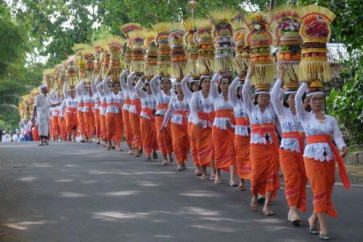Batik for all occasions
It can be something that you wear, use, see, or admire, occasionally or on any occasion
Change text size
Gift Premium Articles
to Anyone

I
t can be something that you wear, use, see, or admire, occasionally or on any occasion.
It can be a sarong that matches your favorite embroidered kebaya to wear at a wedding reception, or it can be a cloth sling your nanny used, to carry you at two years old, as shown in an old photograph in one of your family albums.
It can be your daughter’s tote-bag to carry her net-book or college stuff. It can be an antique wall hanging your mother gave you, or a cool coffee-table you bought in a recent furniture expo.
Batik somehow relates to you on many occasions throughout your life, whether you are aware of it or not, even if you are not Javanese by birth or marriage, and do not live in Jakarta or cities in Java, where the tradition is believed to have originated from.
Batik touches people of all ages and all walks of life, from the cradle to the grave, through all significant life events..
Besides being used to carry a baby, a kain gendong can be used as a sling that can safely “wrap” a baby and cradle him to sleep.
The long, rectangular cloth decorated with symbols that bring luck to a child, can be used as a blanket or a bed-sheet. A kain (piece of cloth) can be a precious family heirloom, worn on special, happy occasions such as weddings, or sad ones, including a funeral service (in Javanese-Islamic custom, it is used to cover the body of a person who has just passed away, before he/she is bathed prior to burial).
Batik can be cheap, when it is just a daster (house dress), or a school uniform your son wears every Thursday, which you can buy for less than Rp 50,000 (about US$5) a piece. But it can cost a fortune, when it is a painting or the Mercedes-Benz C-250 CGi with batik motifs exclusively created by fashion designer Carmanita. The car owned by the lead-guitarist of Padi band, Piyu, is worth over US$110,000.
When President Susilo Bambang Yudhoyono called on all Indonesians to wear batik on Oct. 2, 2009, to celebrate UNESCO’s decision to recognize Indonesian batik as an “Intangible Cultural Heritage of Humanity”, it was a campaign most of us happily responded to. We are proud to wear batik, and have celebrated the day as the National Batik Day ever since.
Batik fashion has developed for decades in Indonesia. It is easy now to find fashionable items made of batik, not only clothing, but also accessories such as shoes and sandals, pouches and bags, or those ethnic necklaces and huge bangles which have become a recent trend.
Batik craftsmanship has also expanded to other products. Batik bed-covers, curtains, cushion covers, or paintings have long established their positions in interior design, while credenzas, tables, beds, or room dividers decorated with the hand-painted, detailed batik motifs, have just made their grand entry into the world of furniture fashion.
The history of batik dates back over centuries. Though experts have found evidence of dye-resistant patterns on cloth from past centuries in India, China, Japan and West Africa, none have developed batik to its present-day art form as the highly developed, intricate batik found on the island of Java in Indonesia. It is clear that in the 19th century, batik was well ingrained in Javanese cultural life.
Javanese royalty were known to be great patrons of the art form and provided the necessary support for its development.
Their structured life inside the palace may have provided the inspiration behind the highly refined traditional designs.
Parang Rusak has a weapon-like (sword) pattern that symbolizes power and strength. Kawung pattern, also worn by the king and his family, symbolizes justice and power. The four circles focused on a point drawn on Kawung means a king is assisted by his servants.
There are patterns that represent important moments in cycle of life; Sido Mukti (means “continuously prosperous”), worn by the bride and groom in their wedding ceremony; and Truntum, pictured as jasmine buds, symbolizes the “guiding” role, and is worn by the parents of the bride and groom.
Experts believe that batik has been preserved not only by royal dynasties, but also by the common people. Mbatik (drawing batik designs) was regarded as an important skill that should be accomplished by a young woman in Central Java, before she could enter married life.
Women in Madura, a tiny island off the East Java coast, developed individual, exclusive designs of birds and plants in their mbatik sessions during the long wait (over six months at times) for their husbands or sons to return from fishing expeditions.
People from the north coast of Java such as Pekalongan and Cirebon have illustrated brighter colors and more intricate flower and cloud designs on their batik due to the great influence of Chinese culture.
The tools in batik making, however, are very simple. The canting, believed to be a purely Javanese invention, is a small, spouted, copper container, connected to a short bamboo handle, filled with melted wax, to be used by the artisan to outline the penciled designs on the cloth. The wajan is the container for the wax, made of iron or clay, which is placed on a small charcoal burner or anglo, to keep the wax melted.
The cap (a copper stamp that makes up a design unit) method was invented in the mid-19th century to speed up the wax application, and make a higher volume and more affordable batik production.
The most experienced artisans normally do the first waxing on the cloth, while filling in of large areas may be entrusted to less experienced ones.
The next step would be applying colors (dyeing). Traditional colors were made from indigo plant (blue), bark of the soga tree (light yellow to dark brown), and mengkudu leaves (dark red). Lighter blue was achieved by leaving the cloth in the dye bath for short periods of time. Green would be achieved by mixing blue with yellow; purple by mixing blue with red. The soga brown would be mixed with indigo to create a dark blue-black color.
Wax would be applied on the cloth, prior to the first dye-bath, in areas of the designs that should be remained uncolored.
In the process, the cloth would be immersed in the hot, dye bath for the first color and re-immersed in subsequent baths until all the desired colors have been applied.
The long, complicated process of creating batik by skilled artisans makes it a unique, cultural legacy for Indonesia, a heritage we should preserve and be proud of.









